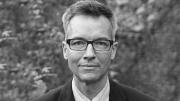After more than a year of study and surveys, the Faculty of Arts and Sciences (FAS) Task Force on Visual Culture and Signage released its report today, with a series of recommendations for achieving a physical campus that better represents Harvard’s “diversity, aspirations, and dynamism.” From sculptures and portraits to landscaping, architecture, and interior design—“all of these elements,” the report states, “bear messages, as powerful as they are implicit, about what the institution values, who it celebrates, and what kind of community it aims to foster.” In response, FAS is creating a new campus curatorship, and initiating changes in three “high-impact” spaces: the Faculty Room in University Hall, Annenberg Hall (where first-year students dine), and the Graduate School of Arts and Sciences’ student center.
Launched in September 2020 by FAS dean Claudine Gay, the task force’s mission grew out of an earlier report, from the Presidential Task Force on Inclusion and Belonging, which in 2018 called for more inclusive campus symbols and spaces. The FAS group was chaired by Robin Kelsey, dean of arts and humanities and Burden professor of photography; among its 21 members were several arts scholars, as well as administrators and faculty members from across Harvard. The group also included four members of the Undergraduate Council and Sheree Ohen, FAS associate dean for diversity, inclusion, and belonging. The task force solicited community input through a listening tour, a survey, a series of focus groups, and an email account to which people could send concerns and ideas. Task force members worked alongside other campus teams “grappling constructively with Harvard’s past,” the report added, including the University’s Committee to Articulate Principles on Renaming and the Presidential Initiative on Harvard and the Legacy of Slavery.
In a letter to the FAS community accompanying the report, Gay announced the creation of a new position, FAS campus curator, who will oversee visual culture and signage, help establish a dynamic program in public art, and provide leadership and expertise to “realize the full promise of the vision” laid out in the task force’s report. Gay also announced the formation of a new standing committee on visual culture and signage, to consult and advise the campus curator. That committee will be headed by Dan Byers, Robinson Family director at the Carpenter Center for the Visual Arts, who also served on the task force.
Many of the report’s recommendations are concrete and specific. Gay noted that among the top priorities for change are three “high-impact” spaces on campus: the Faculty Room, Annenberg Hall, and the Graduate School of Arts and Sciences student center in Lehman Hall. These are places where the FAS community gathers; “they are also spaces,” the report said, “whose visual culture is dominated by homogenous portraiture of white men.” Of the 23 portraits on the walls of Annenberg, for example, none depict women and all but three are of white men. “The exclusion embedded in the current visual culture of these spaces,” the report said, “perpetuates a too-narrow understanding of our institution’s past, present, and future.”
Other recommendations were not confined to the purview of FAS. The report suggested expanding and improving the practices for loaning artworks from Harvard museums to FAS. “At present there are a modest number of works available for loan from museum collections to the FAS community, and those that are available feature too narrow a range of artists, subjects, and themes.” The report also called for changes to campus tours and historical signs and markers. Numerous people who spoke to the task force noted that while tour guides routinely tell the story of Harry Elkins Widener, whose mother endowed the library in his name after he died on the Titanic, they rarely tell visitors about the African American architect, Julian Abele, and his role in designing Widener Library.
The report added that although FAS “hums” with research and teaching, to thousands of tourists and other visitors, the campus is a public museum and historic site. “Few stories about Harvard are visible to anyone navigating our campus,” the report said. “As educators, we should think as creatively about teaching with our outdoor spaces as we do about teaching in our studios, labs, and classrooms.” The report called for an expanded program of tours, including QR codes on physical plaques that could be read by smartphones. The task force also recommended working with the Cambridge Historical Commission to strategize and develop historical signs and markers on FAS outdoor spaces, “with an eye toward telling more equitable and complete stories of the past.”
The report’s other recommendations included:
- Renew FAS visual culture and signage to represent a broader range of peoples, activities and experiences in a variety of artistic media.
- Create a dynamic program of public art in the FAS.
- Encourage curricular innovations that would make FAS visual culture a more integral part of our teaching and learning mission.
- Establish better wayfinding and interpretive signage on the FAS campus.
- Commit to supporting the dynamic curation of FAS spaces over the long term (a multi-facet recommendation that includes developing better care and maintenance protocols for art objects, establishing a well-maintained website to share resources and document changes to visual culture, and creating a dedicated “visual culture innovation fund” to support units and departments as they pursue changes).
“The curation of our campus spaces is not merely an administrative responsibility, it’s a pedagogical opportunity,” Gay wrote in her letter to the FAS community. “Our historical campus is a living laboratory, rich in artifacts, art, and architecture worthy of serious intellectual engagement.” Emphasizing the scale of the report’s ambitions and the “time, patience, and generosity from our community” that will be needed to accomplish them, Gay added, “There is a tremendous amount of exciting work that lies ahead.”









